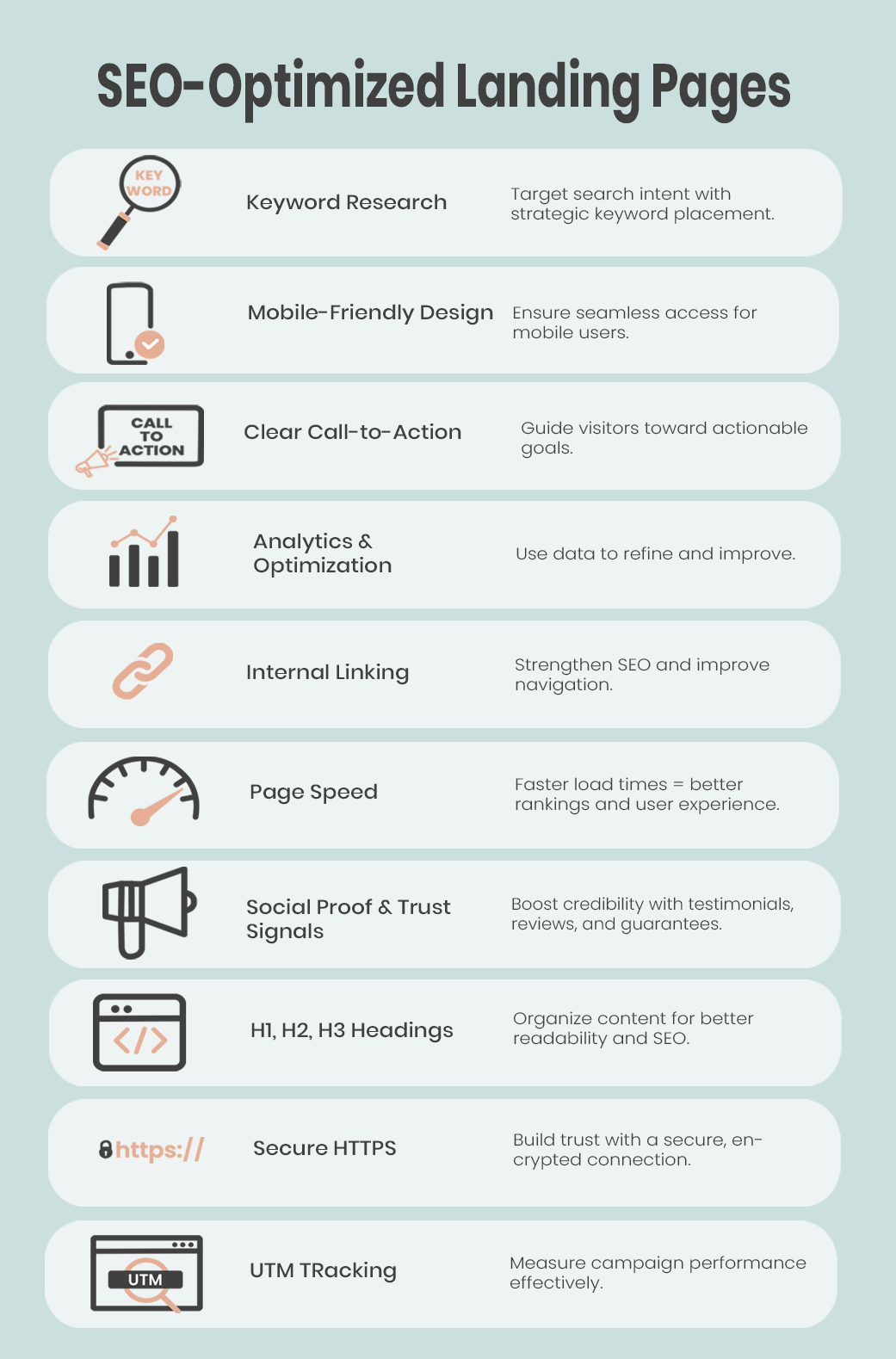SEO-Optimized Landing Pages: The Blueprint for Higher Rankings & Conversions
Christine Solazzi
March 18, 2025
Your landing page is more than just a digital storefront—it’s a conversion engine that can drive traffic, engage visitors, and generate leads when optimized correctly. Here’s a comprehensive guide on how to create SEO-friendly, high-performing landing pages.

Keyword Research: Align with Search Intent
A well-optimized landing page starts with strategic keyword placement. Research and integrate primary and secondary keywords naturally in headings, subheadings, and throughout the content to align with what your audience is searching for.
Pro Tip: Use tools like Google Keyword Planner, SEMrush, or Ahrefs to find high-volume, low-competition keywords that match user intent.
Page Speed: Optimize for Performance
Slow-loading pages frustrate users and hurt search rankings. Google prioritizes fast-loading websites, making page speed a critical SEO factor.
How to Improve Page Speed:
- Compress images using next-gen formats like TinyPNG, reSmush, WP Rocket, and Jetpack.
- Enable browser caching and use a CDN (Content Delivery Network).
- Optimize code by minifying CSS, JavaScript, and HTML.
Mobile-Friendly Design: Ensure Seamless Access
With mobile-first indexing, Google predominantly uses the mobile version of your site for ranking. If your landing page isn’t mobile-friendly, you're losing out on both traffic and conversions.
Best Practices:
- Use a responsive design that adapts to all screen sizes.
- Ensure buttons and CTAs are touch-friendly.
- Keep text readable without zooming.
Internal Linking: Strengthen Site Navigation
Internal links help distribute page authority, improve SEO, and guide users to relevant content.
Internal Linking Strategy:
- Link to related pages and blog posts.
- Use descriptive anchor text with keywords.
- Avoid excessive linking—keep it relevant.
Clear Call-to-Action: Drive User Engagement
Your CTA should be compelling and action-oriented to encourage conversions.
Optimizing Your CTA:
- Use action verbs (“Get Started,” “Download Now”).
- Make it stand out with contrasting colors.
- Place CTAs above the fold and throughout the page.
Analytics & Optimization: Measure & Improve
Tracking user behavior helps refine your strategy and optimize performance.
What to Track:
- Bounce rate & session duration
- Click-through rate (CTR) on CTAs
- Conversion rate & form submissions
Tools like Google Analytics, Hotjar, and Google Tag Manager provide actionable insights.
Schema Markup: Enhance Search Visibility
Structured data helps search engines better understand your content, leading to enhanced rich snippets.
Common Schema Types for Landing Pages:
- Review Schema for ratings and testimonials
- Product Schema for eCommerce landing pages
Use Google’s Structured Data Markup Helper to implement schema effectively.
UTM Tracking: Monitor Campaign Performance
UTMs help track traffic sources and evaluate marketing efforts.
How to Use UTM Parameters:
- Add UTMs to social media and paid ads links.
- Use tools like Google’s Campaign URL Builder.
- Analyze traffic sources in Google Analytics.
SEO-Friendly URL Structure: Keep It Clean & Concise
A clear, readable URL improves both user experience and search rankings.
Best Practices:
- Keep it short and descriptive (e.g., example.com/seo-landing-pages).
- Avoid unnecessary parameters and numbers.
- Use hyphens instead of underscores.
Headings & Content Hierarchy: Improve Readability
Search engines and users rely on a clear heading structure (H1, H2, H3) to navigate content easily.
Optimizing Headings:
- Use one H1 (main title), followed by H2s for sections.
- Include keywords in headings naturally.
- Keep paragraphs short and scannable.
Content Relevance: Write for Humans & Search Engines
Google prioritizes high-quality, valuable content that answers user queries.
Content Writing Tips:
- Address the pain points of your audience.
- Incorporate bullet points and visuals for easy scanning.
- Keep content informative, not overly promotional.
Image & Media Optimization: Speed & Accessibility
Large images slow down your page and affect rankings.
Optimize Images With:
- Compression tools like TinyPNG, reSmush, WP Rocket, and Jetpack
- Descriptive alt text for accessibility and SEO.
HTTPS & Security: Build Trust
A secure website boosts credibility and ranking. HTTPS is a Google ranking factor.
How to Secure Your Site:
- Get an SSL certificate.
- Use secure payment gateways (for eCommerce sites).
- Regularly update software & plugins.
Social Proof & Trust Signals: Boost Credibility
Trust signals reassure visitors and increase conversions.
Effective Trust Signals:
- Testimonials & case studies
- Security badges (SSL, money-back guarantee)
- Press mentions & media coverage
Final Thoughts
A well-optimized landing page isn't just good for SEO—it’s essential for user experience, trust, and conversions. By implementing these best practices, you ensure that your landing page ranks higher, loads faster, and converts better.